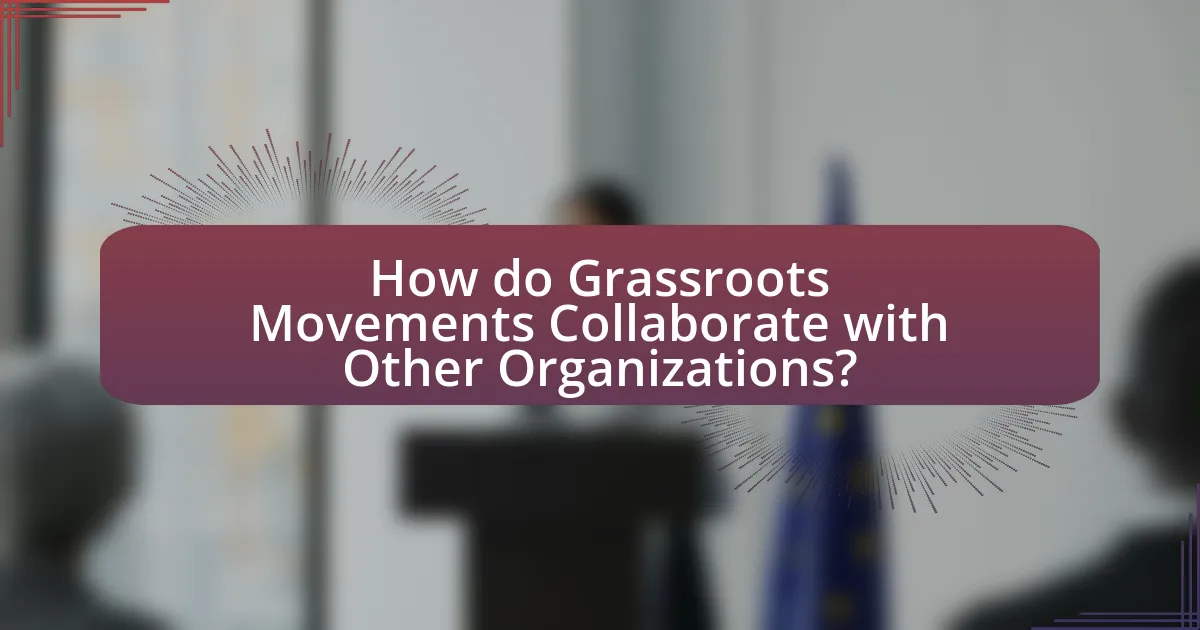Grassroots movements are organized efforts by ordinary citizens aimed at influencing political decisions and policies, particularly during elections. This article examines their significance in mobilizing voters, raising awareness about critical issues, and fostering community engagement, highlighting historical examples such as the Obama campaign in 2008 and the Civil Rights Movement. It explores the strategies employed by grassroots movements, including community outreach, social media utilization, and data analytics, as well as the challenges they face, such as funding limitations and legal hurdles. Additionally, the article discusses the role of partnerships with larger organizations and non-profits in enhancing the effectiveness of grassroots efforts, ultimately illustrating how these movements shape election outcomes and influence political discourse.

What are Grassroots Movements and Their Importance in Elections?
Grassroots movements are organized efforts by ordinary people to influence political decisions and policies, often emerging from local communities. These movements play a crucial role in elections by mobilizing voters, raising awareness about specific issues, and fostering community engagement. For instance, the grassroots campaign of Barack Obama in 2008 effectively utilized social media and local organizing to engage millions of voters, resulting in a historic electoral victory. This demonstrates that grassroots movements can significantly impact election outcomes by amplifying the voices of constituents and driving voter turnout.
How do Grassroots Movements influence voter engagement?
Grassroots movements significantly influence voter engagement by mobilizing communities and fostering a sense of collective action. These movements often utilize local networks to raise awareness about issues, encouraging individuals to participate in the electoral process. For instance, the 2018 midterm elections in the United States saw a surge in voter turnout, attributed in part to grassroots organizations like Indivisible and MoveOn, which engaged millions through door-to-door canvassing and social media campaigns. Research indicates that grassroots efforts can increase voter turnout by as much as 10% in targeted demographics, demonstrating their effectiveness in energizing the electorate and driving participation in elections.
What strategies do Grassroots Movements use to mobilize voters?
Grassroots movements mobilize voters through community engagement, targeted outreach, and leveraging social media. Community engagement involves organizing local events, town halls, and door-to-door canvassing to build relationships and inform voters about issues. Targeted outreach focuses on identifying and reaching specific demographics, often using data analytics to tailor messages that resonate with those groups. Social media platforms are utilized to spread awareness, share information quickly, and create viral campaigns that encourage voter participation. For instance, during the 2020 U.S. elections, grassroots organizations effectively used social media to increase voter turnout among young people, resulting in a significant rise in participation rates compared to previous elections.
How do Grassroots Movements create awareness about issues?
Grassroots movements create awareness about issues by mobilizing community members to engage in collective action and advocacy. These movements utilize various strategies, such as organizing local events, leveraging social media platforms, and disseminating informational materials to educate the public. For example, the Black Lives Matter movement effectively raised awareness about racial injustice through protests and social media campaigns, leading to widespread discussions and policy changes. Additionally, grassroots movements often collaborate with local organizations to amplify their message, ensuring that the issues resonate within the community and reach a broader audience.
Why are Grassroots Movements considered vital in shaping election outcomes?
Grassroots movements are considered vital in shaping election outcomes because they mobilize community engagement and influence voter behavior. These movements often arise from local concerns and can effectively raise awareness about specific issues, leading to increased voter turnout. For instance, the 2008 Obama campaign utilized grassroots organizing to engage millions of volunteers, resulting in a record voter turnout of 61.8%, the highest for a presidential election since 1960. Additionally, grassroots movements can sway undecided voters by fostering a sense of community and shared purpose, as seen in the Tea Party’s impact on the 2010 midterm elections, where they helped elect numerous candidates by emphasizing local issues and grassroots support.
What historical examples illustrate the impact of Grassroots Movements on elections?
Grassroots movements have significantly impacted elections, as evidenced by the Civil Rights Movement in the 1960s, which mobilized citizens to advocate for voting rights, leading to the Voting Rights Act of 1965. This legislation aimed to eliminate barriers to voting for African Americans, resulting in increased voter registration and participation, particularly in the Southern states. Another example is the Tea Party movement in the United States, which emerged in 2009 and influenced the 2010 midterm elections by energizing conservative voters and contributing to significant Republican gains in Congress. Additionally, the Women’s Suffrage Movement, culminating in the passage of the 19th Amendment in 1920, illustrates how grassroots organizing can lead to transformative electoral changes by granting women the right to vote, thereby reshaping the electorate. These examples demonstrate that grassroots movements can mobilize public sentiment, influence policy changes, and alter the political landscape during elections.
How do Grassroots Movements challenge traditional political structures?
Grassroots movements challenge traditional political structures by mobilizing community engagement and advocating for systemic change outside established political channels. These movements often arise in response to perceived inadequacies in representation and can disrupt the status quo by amplifying marginalized voices, thereby influencing public policy and electoral outcomes. For instance, the Civil Rights Movement in the United States effectively challenged segregation laws and led to significant legislative changes, such as the Civil Rights Act of 1964. Additionally, the rise of social media has enabled grassroots movements to organize rapidly and reach wider audiences, further undermining traditional political hierarchies.

What Role do Social Media and Technology Play in Grassroots Movements?
Social media and technology serve as critical tools for grassroots movements by facilitating communication, mobilization, and awareness. These platforms enable activists to quickly disseminate information, organize events, and rally support, significantly amplifying their reach. For instance, during the Arab Spring, social media platforms like Twitter and Facebook were instrumental in coordinating protests and sharing real-time updates, which contributed to the movements’ momentum and visibility. Additionally, a study by the Pew Research Center found that 69% of adults in the U.S. use social media, highlighting its potential to engage a broad audience and influence public opinion. Thus, social media and technology not only enhance the operational capabilities of grassroots movements but also play a pivotal role in shaping political discourse and outcomes.
How has social media transformed Grassroots Movements?
Social media has transformed grassroots movements by enabling rapid organization, widespread communication, and increased visibility. Platforms like Twitter and Facebook allow activists to mobilize supporters quickly, share information in real-time, and amplify their messages to a global audience. For instance, the #BlackLivesMatter movement gained significant traction through social media, leading to large-scale protests and influencing public discourse on racial justice. According to a study by the Pew Research Center, 69% of adults in the U.S. use social media, highlighting its role as a critical tool for grassroots engagement and activism. This transformation has made it easier for movements to gain momentum and impact election outcomes by shaping public opinion and voter mobilization efforts.
What platforms are most effective for Grassroots Movements?
Social media platforms, particularly Facebook, Twitter, and Instagram, are the most effective for grassroots movements. These platforms enable rapid information dissemination, community building, and mobilization of supporters. For instance, Facebook’s targeted advertising and event creation features allow grassroots organizations to reach specific demographics and organize rallies or meetings efficiently. Twitter’s real-time communication facilitates the spread of messages and updates, while Instagram’s visual storytelling engages younger audiences effectively. According to a study by the Pew Research Center, 69% of adults in the U.S. use Facebook, making it a crucial tool for grassroots outreach and engagement.
How do Grassroots Movements utilize data analytics for campaigning?
Grassroots movements utilize data analytics for campaigning by analyzing voter demographics, preferences, and behaviors to tailor their outreach strategies effectively. These movements collect data from various sources, including social media interactions, surveys, and public records, to identify key issues that resonate with their target audience. For instance, the 2018 midterm elections saw grassroots organizations leveraging data analytics to mobilize voters by focusing on local concerns, which resulted in increased voter turnout in several districts. This strategic use of data not only enhances campaign messaging but also optimizes resource allocation, ensuring that efforts are concentrated where they can have the most impact.
What challenges do Grassroots Movements face in modern elections?
Grassroots movements face significant challenges in modern elections, including limited funding, media visibility, and organizational capacity. Limited funding restricts their ability to compete with well-funded political campaigns, making it difficult to reach a broader audience. Media visibility is often skewed towards larger parties, which diminishes the exposure grassroots movements receive, despite their potential to mobilize community support. Additionally, organizational capacity can be a hurdle, as many grassroots movements rely on volunteers and lack the infrastructure necessary for effective campaign management. These challenges collectively hinder their impact on election outcomes, as evidenced by the 2020 U.S. elections where smaller movements struggled to gain traction against established political entities.
How do funding and resource limitations affect Grassroots Movements?
Funding and resource limitations significantly hinder grassroots movements by restricting their ability to mobilize, organize, and communicate effectively. Without adequate financial support, these movements struggle to cover essential costs such as outreach materials, event logistics, and digital platforms for engagement. For instance, a study by the National Democratic Institute found that grassroots organizations with limited funding often fail to reach broader audiences, resulting in decreased voter turnout and engagement during elections. Additionally, resource constraints can lead to reliance on a smaller base of volunteers, which may limit the diversity and inclusivity of the movement, ultimately affecting its impact on election outcomes.
What legal and regulatory hurdles do Grassroots Movements encounter?
Grassroots movements encounter various legal and regulatory hurdles, including restrictions on campaign financing, compliance with election laws, and limitations on public assembly. These movements often face challenges in fundraising due to regulations that limit contributions and require transparency, which can hinder their ability to mobilize resources effectively. Additionally, grassroots organizations must navigate complex election laws that dictate how they can engage in political activities, often requiring them to register as political committees or face penalties. Furthermore, local and state regulations may impose restrictions on protests and public gatherings, impacting their ability to organize and advocate for their causes. These legal barriers can significantly impede the effectiveness and reach of grassroots movements in influencing election outcomes.

How do Grassroots Movements Collaborate with Other Organizations?
Grassroots movements collaborate with other organizations through strategic partnerships, resource sharing, and coordinated campaigns. These collaborations often involve aligning goals and objectives, which enhances their collective impact on social and political issues. For instance, grassroots movements may partner with established non-profits or advocacy groups to leverage their networks and expertise, thereby increasing outreach and mobilization efforts. A notable example is the collaboration between grassroots organizations and larger civil rights groups during the 2020 U.S. elections, where they worked together to increase voter registration and turnout among underrepresented communities. This synergy not only amplifies their voices but also fosters a more inclusive political landscape.
What partnerships enhance the effectiveness of Grassroots Movements?
Partnerships with local organizations, non-profits, and community leaders enhance the effectiveness of grassroots movements. These collaborations provide essential resources, local knowledge, and networks that amplify outreach efforts. For instance, research by the Stanford Social Innovation Review highlights that grassroots movements that partner with established organizations can leverage funding and expertise, leading to increased visibility and impact in electoral processes. Additionally, alliances with social media platforms enable grassroots movements to engage a broader audience, facilitating rapid information dissemination and mobilization.
How do Grassroots Movements align with larger political organizations?
Grassroots movements align with larger political organizations by mobilizing community support and advocating for specific issues that resonate with the broader political agenda. These movements often serve as a foundation for larger organizations by providing grassroots activism, which can influence policy decisions and electoral outcomes. For example, the Civil Rights Movement in the United States, which began as grassroots activism, significantly impacted the Democratic Party’s platform in the 1960s, leading to the passage of landmark legislation like the Civil Rights Act of 1964. This alignment occurs as grassroots movements leverage their local networks to amplify the messages and goals of larger organizations, creating a symbiotic relationship that enhances political engagement and voter turnout.
What role do non-profits play in supporting Grassroots Movements?
Non-profits play a crucial role in supporting grassroots movements by providing funding, resources, and organizational expertise. They often mobilize community members, facilitate training, and create networks that amplify the voices of grassroots activists. For instance, organizations like the Sierra Club and the NAACP have historically supported grassroots efforts by offering financial backing and strategic guidance, which enhances the effectiveness of local initiatives. This support is vital for grassroots movements to gain visibility and influence, particularly in shaping election outcomes, as evidenced by the increased voter turnout and engagement driven by non-profit-led campaigns during pivotal elections.
What best practices can Grassroots Movements adopt for success?
Grassroots movements can adopt several best practices for success, including building a strong community base, leveraging social media for outreach, and fostering inclusive participation. A strong community base ensures that the movement has local support and resources, which is critical for mobilization. For instance, the 2018 midterm elections in the United States saw grassroots organizations like Indivisible effectively mobilizing local communities to increase voter turnout. Leveraging social media allows movements to reach a broader audience quickly and efficiently; studies show that social media campaigns can significantly enhance engagement and awareness. Additionally, fostering inclusive participation ensures diverse voices are heard, which strengthens the movement’s legitimacy and appeal. Research indicates that movements with diverse leadership are more successful in achieving their goals, as seen in the Women’s March, which united various demographics to advocate for women’s rights.
How can Grassroots Movements effectively measure their impact?
Grassroots movements can effectively measure their impact by utilizing a combination of quantitative and qualitative metrics, such as voter turnout, engagement levels, and community feedback. For instance, analyzing changes in voter registration and turnout rates in areas where grassroots campaigns are active provides concrete data on electoral influence. Additionally, surveys and interviews can capture community sentiment and awareness regarding issues championed by the movement, offering insights into shifts in public opinion. Research indicates that movements that track these metrics can demonstrate their effectiveness in mobilizing support and influencing election outcomes, as seen in studies like “The Impact of Grassroots Movements on Political Participation” published in the Journal of Political Science, which highlights measurable changes in voter behavior linked to grassroots efforts.
What strategies can Grassroots Movements implement to sustain momentum post-election?
Grassroots movements can sustain momentum post-election by establishing ongoing community engagement initiatives. These initiatives can include regular town hall meetings, workshops, and social media campaigns that keep supporters informed and involved. For instance, the Women’s March organization has successfully maintained its influence by organizing annual marches and advocacy events, which mobilize participants and keep the conversation alive around women’s rights issues. Additionally, forming coalitions with other organizations can amplify their reach and resources, as seen in the collaboration between various environmental groups to push for climate action after elections. By focusing on continuous advocacy and community-building efforts, grassroots movements can effectively maintain their momentum and influence in the political landscape.





